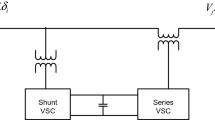Abstract
This paper presents an application of multiobjective cuckoo search (MOCS) algorithm for reduction in transmission line losses by placing static VAR compensator (SVC) at an optimal location. MOCS algorithm is an extension of the infamous cuckoo search algorithm. The multiobjective optimizations considered in this paper include active power loss and reactive power loss, active power loss and investment cost of SVC. The Pareto-optimal solution which is obtained by using the Pareto-optimal method gives the solution to the multiobjective problem. The fuzzy logic approach is used to obtain best trade-off solutions from the Pareto-optimal solution. A standard IEEE 30 bus test system is considered for testing the efficacy of the proposed methodology. The results show that installation of SVC and application of MOCS algorithm is effective in power loss reduction.





Similar content being viewed by others
References
Abdel Moamen MA, Narayana Prasad P (2003) Power flow control and transmission loss minimization model with TCSC for practical power networks. In: IEEE power engineering society general meeting, Toronto, Canada, pp 880–884
Ambriz Perez H, Acha E, Fuerte Esquivel CR (2000) Advanced SVC models for Newton–Raphson load flow and newton optimal power flow studies. IEEE Trans Power Syst 15(1):129–136
Civicioglu P, Besdok E (2013) A conceptual comparison of the cuckoo-search, particle swarm optimization, differential evolution and artificial bee colony algorithms. Artif Intell Rev 39(4):315–346
Gerbex S, Cherkaoui R, Germond AJ (2001) Optimal location of multi-type FACTS devices in a power system by means of genetic algorithms. IEEE Trans Power Syst 16(3):537–544
Hingorani NG, Gyugyi L (2000) Understanding FACTS: concepts and technology of flexible AC transmission Systems. IEEE Press, New York
Idris RM, Khairuddin A, Mustafa MW (2009) Optimal allocation of FACTS devices for ATC enhancement using bees algorithm. In: IEEE power engineering conference, Adelaide, Australia pp 313–320
Kumar Pradeep, Kumar Niranjan, Akella Ashok Kumar (2016) Comparative analysis of voltage and current source inverter based DSTATCOM systems. Turk J Electr Eng Comput Sci 24(5):3838–3851
Lu Z, Li MS, Tang WJ, Wu QH (2007) Optimal location of FACTS devices by a bacterial swarming algorithm for reactive power planning. In: IEEE evolutionary computation, Singapore, pp 2344–2349
Mahdad Belkacem, Srairi Kamel (2014) Optimal location and control of combined SVC–TCSC controller to enhance power system loadability. Int J Syst Assur Eng Manag 5(3):427–434
Mani Sankar M, Seksena SBL (2017) A cost effective voltage sag compensator for distribution system. Int J Syst Assur Eng Manag 8(1):56–64
Pavlyukevich I (2007) Levy flights, non-local search and simulated annealing. J Comput Phys 226(2):1830–1844
Saravanan M, Slochanal SMR, Venkatesh P, Prince Stephen Abraham J (2007) Application of particle swarm optimization technique for optimal location of FACTS devices considering cost of installation and system loadability. Electr Pow Syst Res 77(3–4):276–283
Shaheen Husam I, Rashed Ghamgeen I, Cheng SJ (2011) Optimal location and parameter setting of UPFC for enhancing power system security based on differential evolution algorithm. Int J Electr Power 33(1):94–105
Solmaz K, Amin MH, Hazlie Bin M (2015) Comparative study of multi-objective optimal power flow based on particle swarm, evolutionary programming, and genetic algorithm. Electr Eng 97(1):1–12
Viswanathan GM, Raposo EP, da Luz MGE (2008) Lévy flights and super diffusion in the context of biological encounters and random searches. Phys Life Rev 5(3):133–150
Yang XS, Deb S (2009) Cuckoo search via l´evy flights. In: IEEE world congress on nature and biologically inspired computing, Coimbatore, India, pp 210–214
Yang XS, Deb S (2010) Engineering optimization by cuckoo search. Int J Math Model Numer Optim 1(4):330–343
Yang XS, Deb S (2011) Multiobjective cuckoo search for design optimization. Comput Oper Res 40(6):1616–1624
Author information
Authors and Affiliations
Corresponding author
Ethics declarations
Conflict of interest
All the authors do not have any conflict of interest.
Human and animal rights statement
This article does not contain any studies with human participants or animals performed by any of the authors.
Additional information
Communicated by V. Loia.
Publisher’s Note
Springer Nature remains neutral with regard to jurisdictional claims in published maps and institutional affiliations.
Rights and permissions
About this article
Cite this article
Nartu, T.R., Matta, M.S., Koratana, S. et al. A fuzzified Pareto multiobjective cuckoo search algorithm for power losses minimization incorporating SVC. Soft Comput 23, 10811–10820 (2019). https://doi.org/10.1007/s00500-018-3634-7
Published:
Issue Date:
DOI: https://doi.org/10.1007/s00500-018-3634-7




